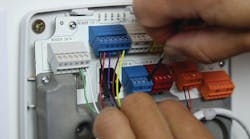Having spent nearly three decades in the security industry — ten years of which were spent as a sales rep for a security integrator — I have learned a lot about what it takes to make an access control install go smoothly. While there have been many technological advances in the past 30 years, many of the lessons I learned years ago are as valuable today as when I first experienced them.
As I walk you through the process, take note of the most common pitfalls to avoid.
The Pre-Install Review
You just designed the perfect access control system for the customer and they signed on the dotted line. So now you enter into the pre-install phase of the project. The main thing that can trip you up at this stage is finding out you omitted a crucial detail in the planning.
Remember the old adage, “Measure twice. Cut once?” The same applies here. You need to double check all the moving parts, and there are a lot of them.
1. Is everyone in agreement on project parameters? The first step would be to set up a meeting with the installation manager/installation team to review the project as a whole. You need to go over the equipment listing that was quoted to ensure it is correct and coincides with the design of the system being installed. Review the labor requirements for the project and make sure the figures quoted accurately reflect the manpower needed to complete the job. As I mentioned in my September article, I once did a labor quote for a project where I was unaware that the installation in some areas of the facility needed to be done after normal business hours or on weekend — ouch! That led to a rather unpleasant discussion with the install manager. Thankfully, the customer realized that they had not specified that restriction to me and allowed a rider to the project for additional labor — whew!
2. Who are all the players on the project? If you are going to be using subcontractors for any portion of the install, they need to be involved in the pre-install meetings. Tasks need to be assigned so everyone involved knows who is responsible for what steps. For example, who will be installing the locks, and at what stage will the locks be left for the installers to connect? Will the customer provide the electrical requirements needed for the project, such as the network cabling and drops to the doors, network switches if using PoE, etc.? If lifts are required, who is responsible for providing them?
3. Are all the permits in order? Make sure all the permits required for the project are obtained from the local authority before the installation begins. It is never a good situation when the install team is onsite during the install and a building inspector walks in, asks to see the permits and is met with a blank stare. It has happened to me, and I assure you that nothing angers the site team more than being told to halt the install.
4. Has everyone signed off on the checklist? One other key pre-install item would be to complete an installation checklist. This document is used to review all of the above, and it needs to be signed by both the installation team and the end-customer to eliminate any surprises, headaches and heartaches once the installation begins. If you and your company have not used checklists in the past, trust me — now is a good time to start.
Confirming Customer Expectations
Once the install team has gone through their side of the contract with a fine-tooth comb, the next step would be to meet with the end-customer for a final review of the system’s physical design. Now is the time to go over any blueprints to ensure the doors to be secured are all listed accurately with proper descriptions. You should also create a customer checklist to review the access control features the customer expects from the software. Good documentation is critical to ensure that the installation process runs smoothly and that the end product delivered matches what the customer thought they were purchasing.
1. Name that door. If the customer provides the integrator with a list of door naming, groups, access levels and time schedules from the onset of the installation it helps the installer expedite the loading and programming of the system software. Otherwise, installation progress will likely slow to a crawl.
2. Name that system administrator. Next would be determining who is responsible for adding cardholders to the software database. The integrator might do this for a small cardholder population if it was figured into the labor costs. For a very large database of cardholders, the end-customer might assign one of their own employees to do the data entry in order to keep project costs in check. If the install is replacing an older system, can any of the existing data be imported directly into the new software? If so, who will be responsible for that task?
3. Look to the future. It’s certainly important to review features that are needed today. But also review system software features not currently designated to be used that would stand the customer in good stead for future enhancements or expansion. It makes them feel like they’re getting a little something extra in the bargain and helps them appreciate the long-term value of the system you’ve sold them.
The Underlying Computer System and Software
Do not forget the hardware that will be running the access control software. A good software provider will either supply the appropriate computers or have detailed specifications on system requirements if the integrator or end-user will be providing the hardware.
It is important to decide who is providing the server and client hardware before you complete the design. And since these components will likely run on the customer’s network which is the province of their IT department, the IT department will probably have some questions and want to have input on the hardware and software technology you choose for the installation.
Customer Training
It does not help to have the best access control system in the world if the customer does not know how to use it properly. Training on the software is another key to a successful installation.
Like every other component of the project, the parameters for training should be established with the customer prior to the install. How many people will need to be trained? How much time is to be allotted per employee and how should that service be priced out? For example, if the customer wants to pay for eight hours of staff training, will it be a one-day, eight-hour training class or will it be split into two four-hour days? You want to avoid being caught in the uncomfortable position of haggling particulars after the contract is signed.
Establishing Milestones
Keeping a project on schedule and on budget has its challenges; however, if everyone agrees to specific milestones at the onset, you are more likely to achieve your goal. To avoid unnecessary and costly delays, the customer and integrator need to agree on a completion date and whether there will be any penalties to the integrator for not meeting that date.
Reviewing the system design and customer checklist at the onset of the project prevents the customer from introducing new restrictions mid-project that would cause any delays and increase the cost of the install. Once the customer agrees to the completion schedule, they should sign the checklist to avoid any misunderstandings down the road. From my experience, I know it is not possible to anticipate every possible scenario that the install team may run into, but doing your best to prepare for them should certainly help alleviate any major issues.
Using the install guidelines I’ve mentioned should make the installation process go smoothly and keep stress levels to a minimum for both the integrator and the customer. In the end, that’s what helps you build a good long-term relationship with your customer for further projects and enhancements.
Bruce Stewart is Business Development Manager for Access Control at Axis Communications. Request more info about Axis at www.securityinfowatch.com/10212966.
Other Articles in this Series
This the final article in this four-part series on IP-based physical access control systems. Here are the links to the other articles:
- The Case for IP Access Control, by Scott Dunn (SD&I Feb. 2014) – www.securityinfowatch.com/11296103
- Why PACS Are Moving to the Edge, by Bruce Stewart (SD&I June 2014) – www.securityinfowatch.com/11456330
- How to Sell PACS, by Bruce Stewart (SD&I Sept. 2014) – www.securityinfowatch.com/11625086







